After we decided to head out west for 2021, I went down a bit of a rabbit hole on Airstream Dog’s website. They’ve done a lot of traveling out west and they seem to enjoy doing a lot of the same stuff that we do – outdoor activities, hiking, pet-friendly activities, breweries, etc.
While checking out some of the stuff that they did in New Mexico, I saw a comment their uncle made about visiting Chaco Culture National Historical Park. After looking into it a little online I knew this was somewhere we’d want to check out, so I added it to our list.
Our first stop in New Mexico was Bloomfield, a small town in the northwest of the state, about half an hour from Farmington. New Mexico required that visitors in the state self-quarantine for 14 days when they arrived due to COVID (we arrived at the end of January 2021), so after completing those two weeks at our Airbnb we ventured down to Chaco Culture National Historical Park.
Google Maps said the journey would take about 75 minutes, but it ended up taking closer to 100 minutes due to the rough road you encounter after getting off Hwy 550. The road isn’t too bad initially, but then it gets rough for about 20 miles. If you have an SUV or high-clearance vehicle it’s probably not too bad, but our 2004 Toyota Corolla didn’t appreciate it. It gets incredibly bumpy, so at times we were barely going more than 10-15 mph.
The journey in and out of the park therefore wasn’t much fun, but don’t let that put you off visiting – Chaco Culture National Historical Park is a fascinating place and so was well worth the bumpiness.
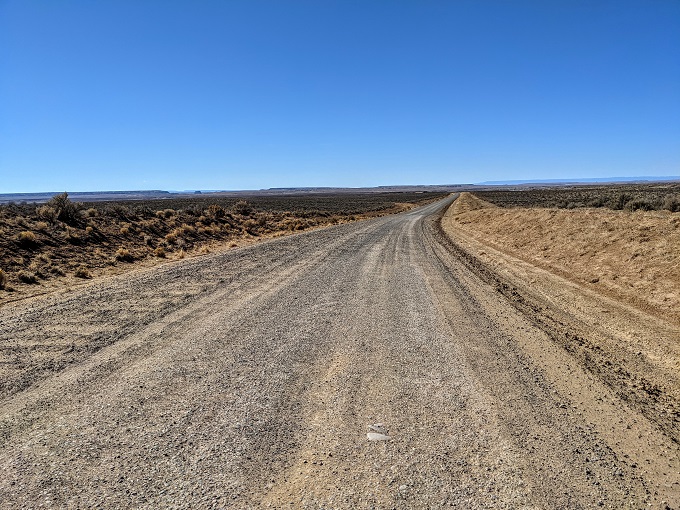
We were relieved when we eventually reached the park as once you enter the road is properly paved again.

After entering the park, we continued driving a couple of miles until we reached the visitor center.
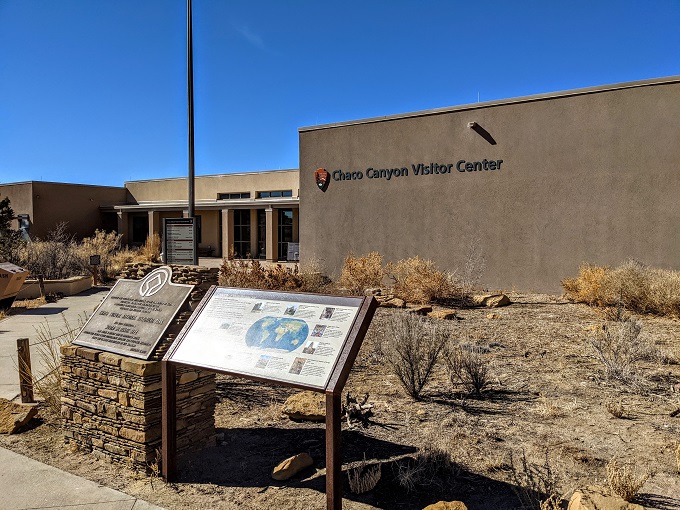
Due to COVID, the visitor center was closed. To ensure visitors still had access to all the information they needed, there was a table set up outside with a couple of binders containing all kinds of sheets with information about the park. Ahead of our visit I wasn’t sure what kind of maps and information would be available, so I saved a bunch of pages from the NPS website as PDFs, emailed them to myself and downloaded them to my phone before we left our Airbnb that morning.
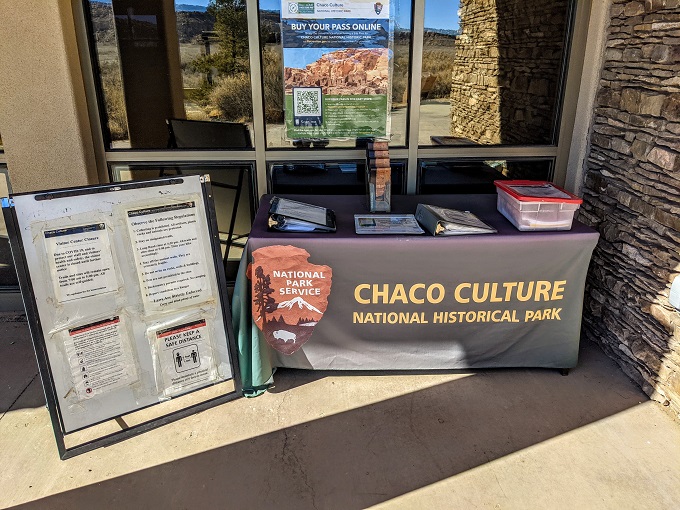
The table also had information about how to pay the entrance fee. Seeing as the site is a National Historical Park, it was covered by our annual pass. We’d bought a pass last March as we were expecting to visit lots of National Parks in 2020, but the pandemic had other ideas and we ended up heading back east for the rest of the year. It was therefore good to get some more use out of it before we renew it next month.
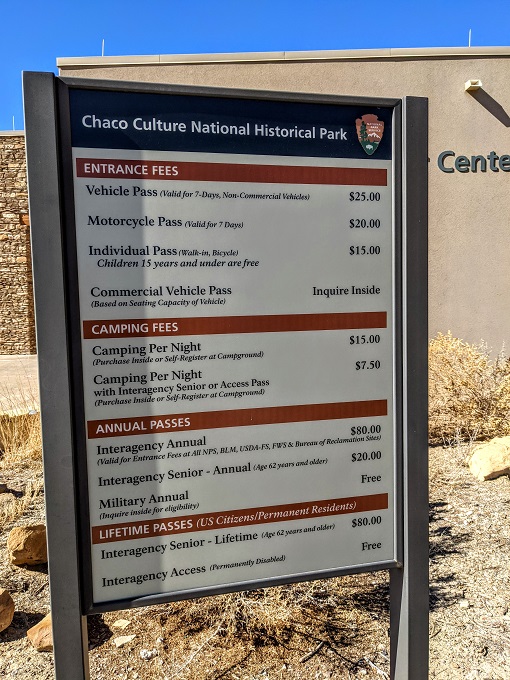
Although the visitor center was closed, the restrooms were open as they were in a standalone building. They were nice and clean and had running water; there was at least one other restroom in the park, but that one didn’t have running water.
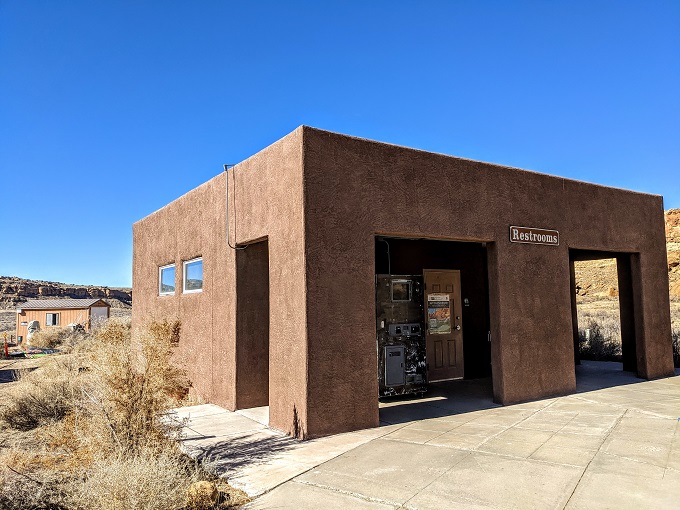
If you want a comfortable spot to have some lunch, there are picnic tables to the left of the visitor center, as well as a couple more to the right of the restroom.
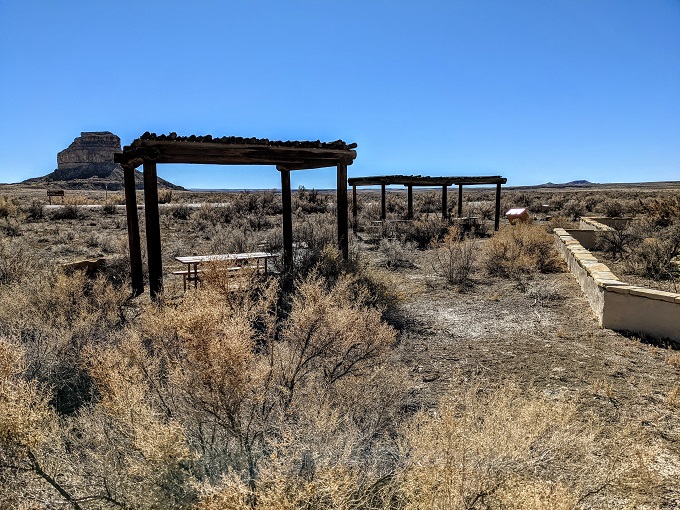
The water fountains outside the restrooms were turned off, but there was a sign advising that there was drinking water available off to the right.

One of the leaflets at the visitor center was a guide to the park which contained a map. Chaco Culture National Historical Park has a one-way road running through it, circling Chaco Canyon.
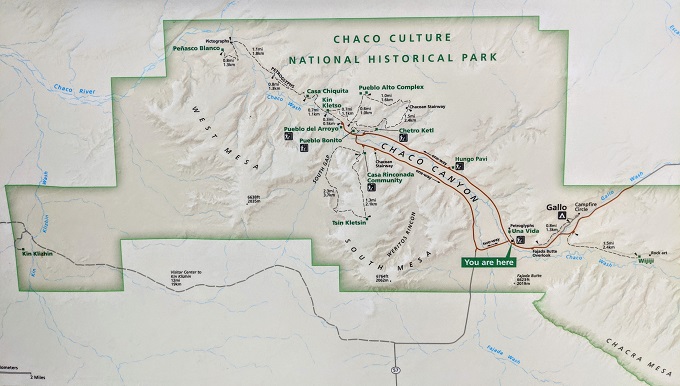
There are six main sites to see:
- Una Vida
- Hungo Pavi
- Chetro Ketl
- Pueblo Bonito
- Pueblo del Arroyo
- Casa Rinconada
In addition to those main sites which you can access by car, there are several other outlier sites which you can access via hiking trails. Those include:
- Pueblo Alto Complex
- Casa Chiquita
- Kin Kletso
- Peñasco Blanco
- Tsin Kletsin
- Wijiji
We didn’t have enough time to do any hiking that day as the six main sites took several hours to explore, so that unfortunately meant we missed out on seeing the outlier sites. Chaco Culture National Historical Park has a campground (which is currently closed due to COVID), so if you’re into camping it could be worth spending a few days at the park to be able to explore everything.
In addition to having more time to explore the park, camping there also means you’ll be able to take advantage of the fact that it’s an International Dark Sky Park. They’ve been able to get that designation due to there being such little light pollution that you can see the stars and Milky Way far more clearly at night.
Una Vida
The first of the six main sites – Una Vida – can be accessed from the parking lot at the visitor center.
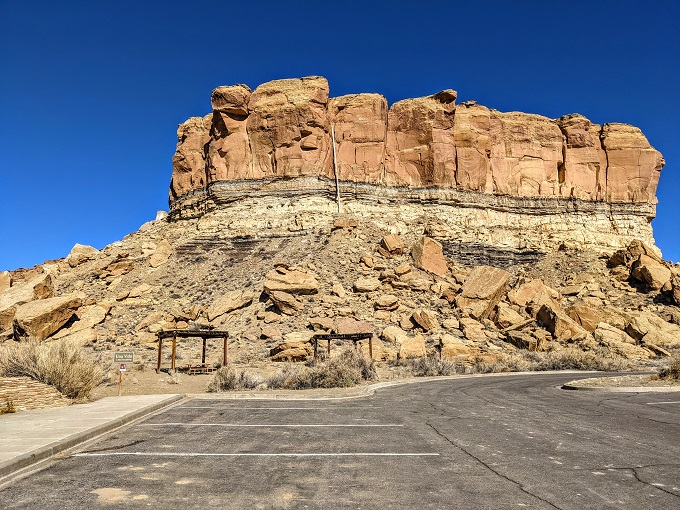
The Una Vida trail is a one mile loop and takes in a Chacoan great house, along with some petroglyphs.
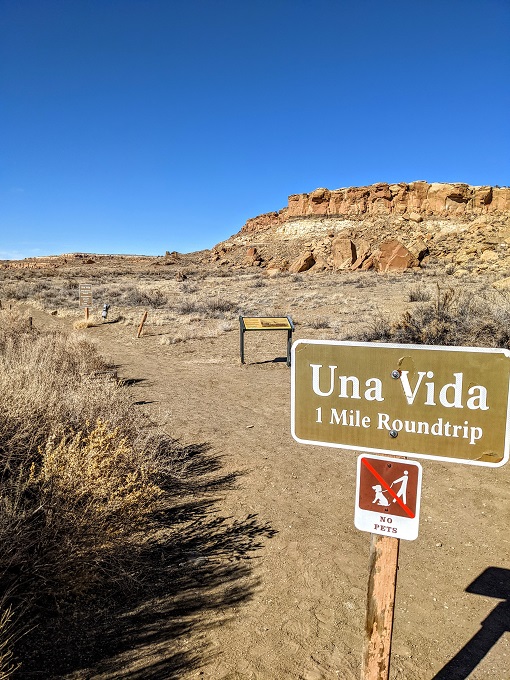
The great house once contained more than 100 ground floor rooms and kivas, as well as a great kiva in an enclosed plaza.
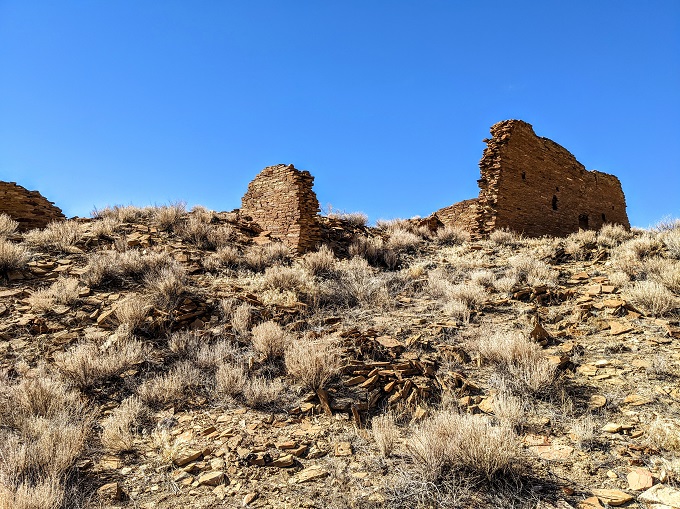

While walking around Chaco Culture National Historical Park, it’s worth paying attention to the masonry as there are several different construction types.
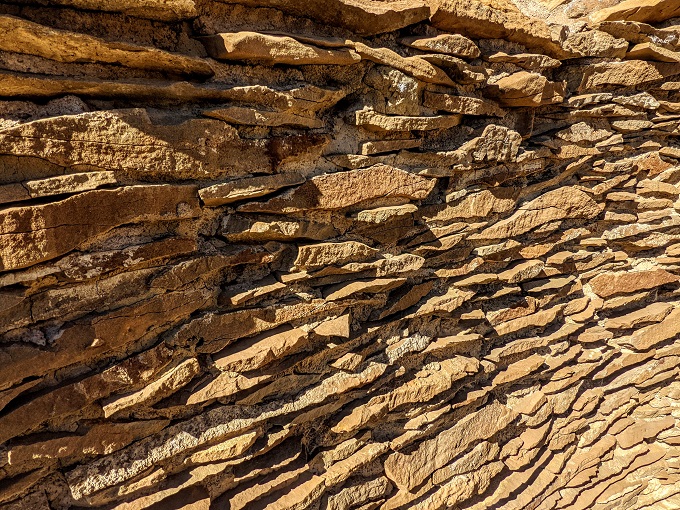
There were several areas which were numbered both at Una Vida and other sites in the park. In the binders at the visitor center there were sheets of paper with information corresponding to these numbers. I didn’t realize until I looked in our glove box today (a week after our visit) that we’d actually picked up some of those sheets – I’d thought that information was perhaps only available in leaflets when the visitor center was open. We therefore unfortunately missed out on learning about some of the things that we were looking at!
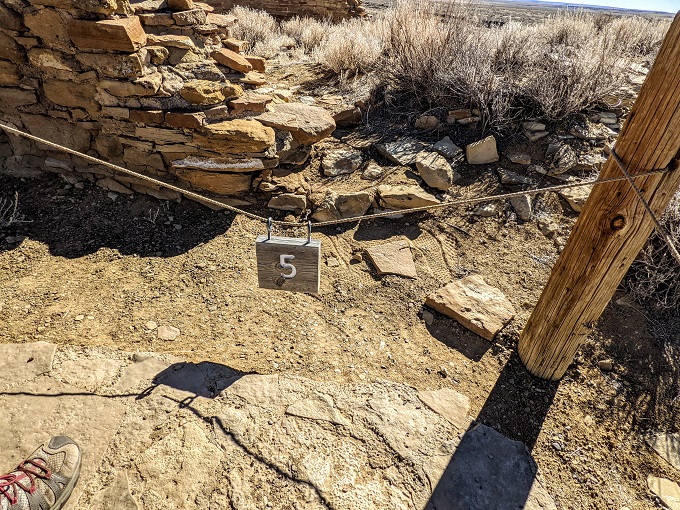
Construction on Una Vida began in ~850 A.D. and continued for more than 250 years. Unlike some of the other sites, Una Vida has only had minor excavations and preservation repairs.
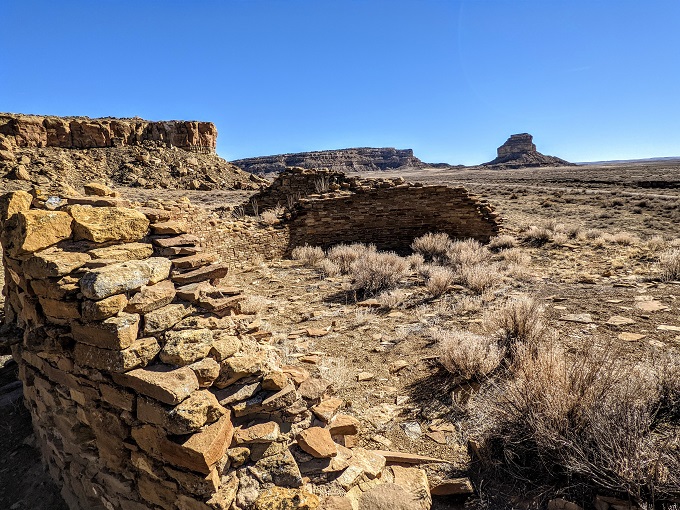
The trail continues uphill, providing a different view of the site.

Keep an eye out as you walk along the trail as there are some petroglyphs on the rock face to the right. There’s a conglomeration of them all on the same rock and are much more distinct than many of the petroglyphs we saw at Petroglyph National Monument in Albuquerque.
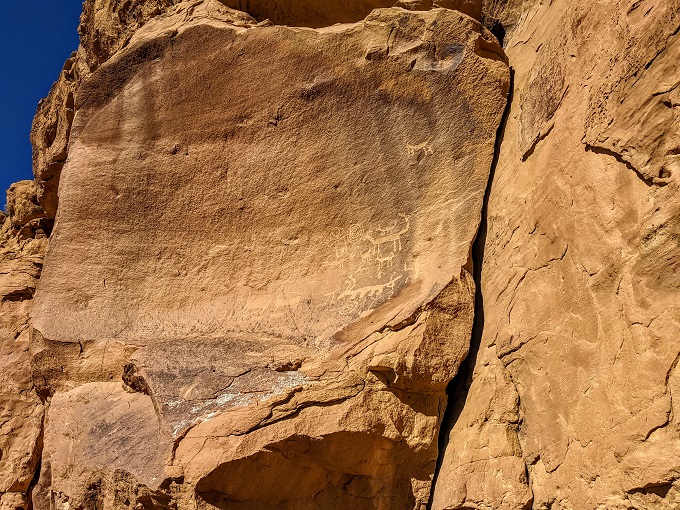
If you’re worried about missing out on some of the petroglyphs on the trail, keep an eye out for the signs labeled ‘P’ which point up at them.
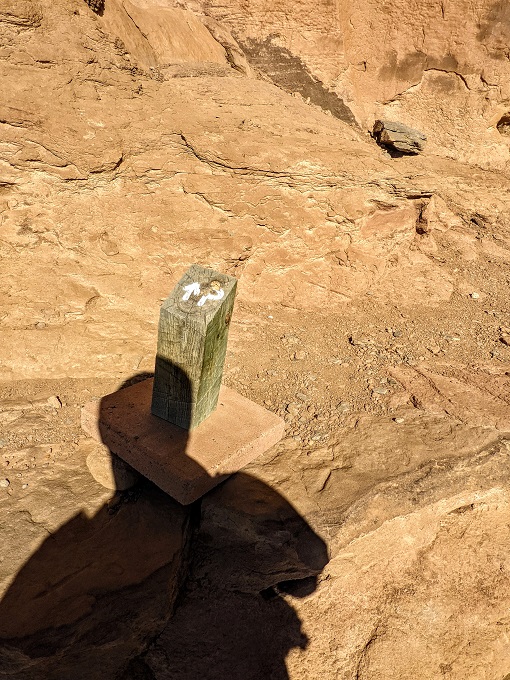
On our way back to the parking lot, Shae spotted another petroglyph of a person or creature on the bottom right corner of this boulder.
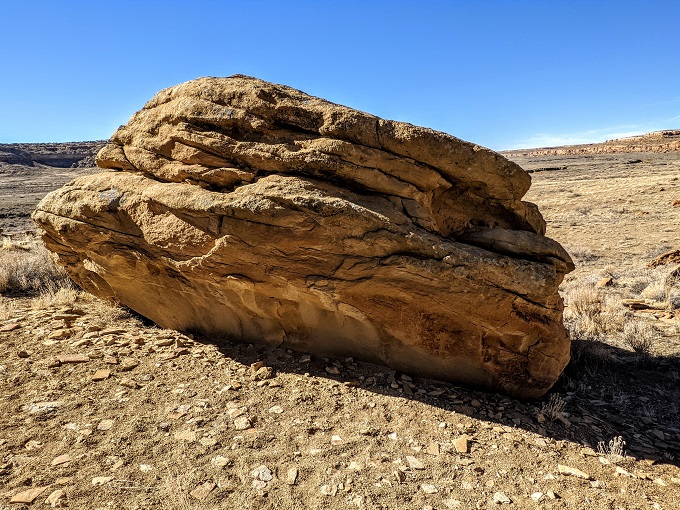
Hungo Pavi
After getting back to the car, we drove a couple of miles down the road to the second site – Hungo Pavi. The trail is shorter than Una Vida as it’s only about 0.25 miles round trip.
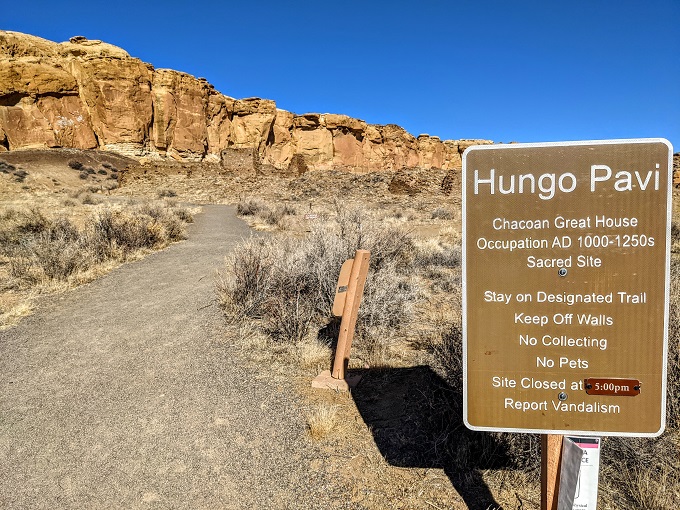
Hungo Pavi was another Chacoan great house, with this building containing more than 150 rooms, a great kiva and an enclosed plaza. Similar to Una Vida, this site hasn’t been excavated and so you don’t get quite as much of a sense of the great house’s immensity as you do with some of the later sites.
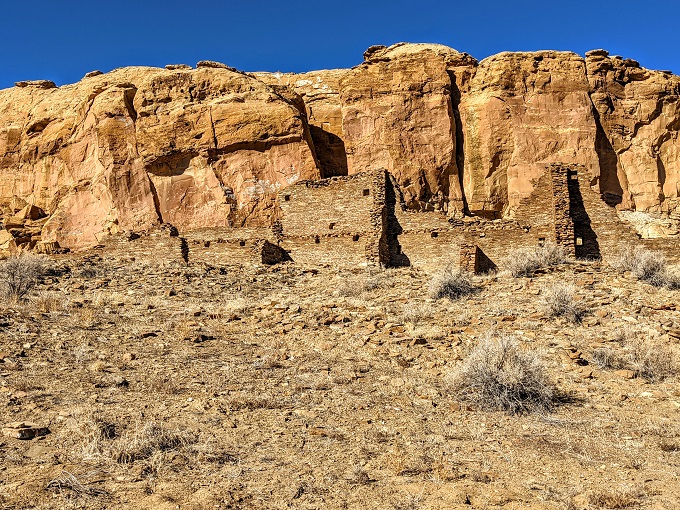
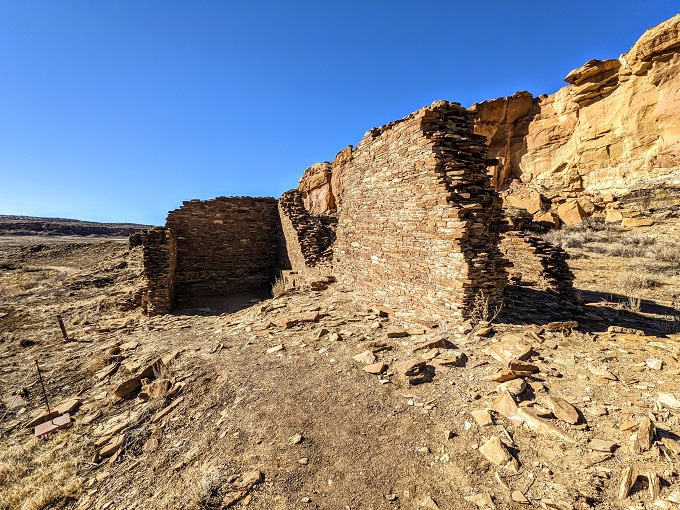
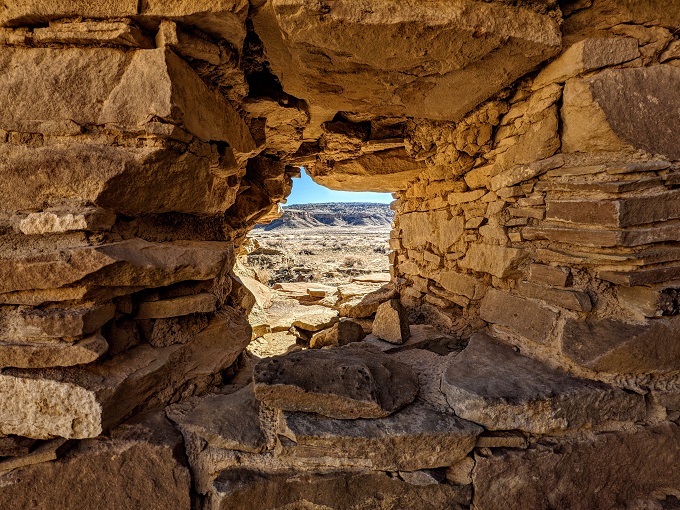
This great house appeared to have different masonry to Una Vida, as well as some additional architectural features like wooden supports.
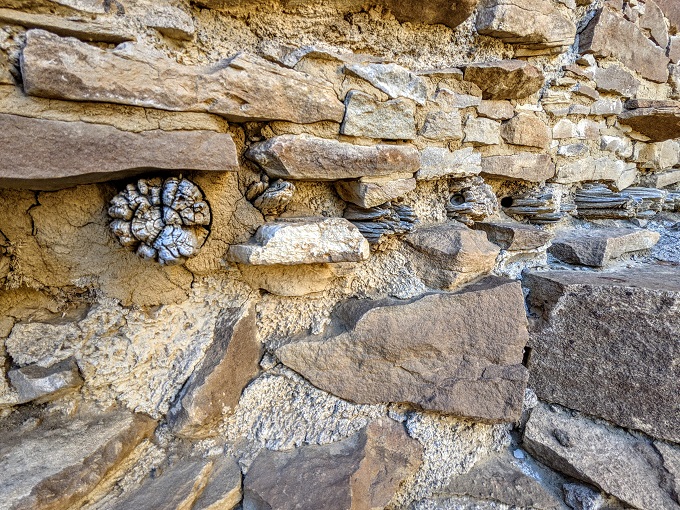
I mentioned that the unexcavated nature of this great house means you don’t get a true sense of its original size, but the long wall helps give an idea of how large the building was.
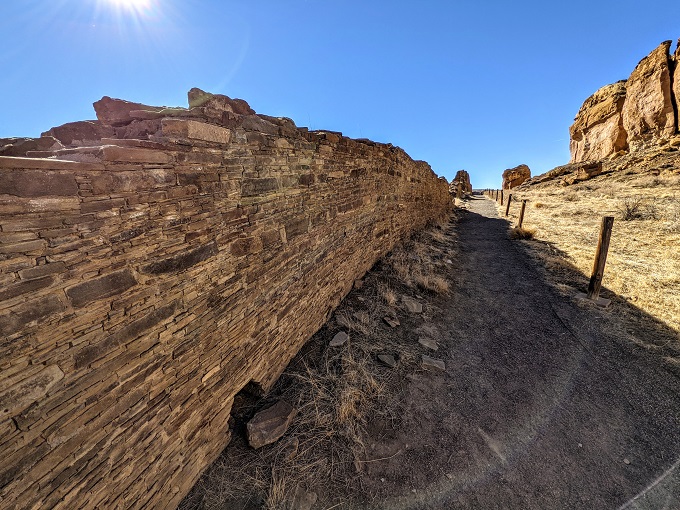
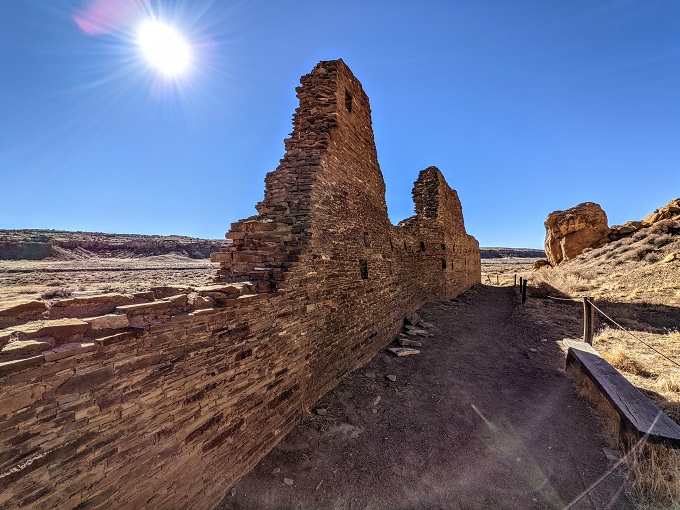
One of the curious features of the building is all of its wooden supports, especially these larger logs. The curious feature isn’t because the Chacoan people used wood per se, but because there were no trees to be seen in Chaco Canyon, nor did we remember seeing any on the drive in to the park. The Chacoan people therefore had to transport the trees from many miles away to aid with the construction of the great houses.
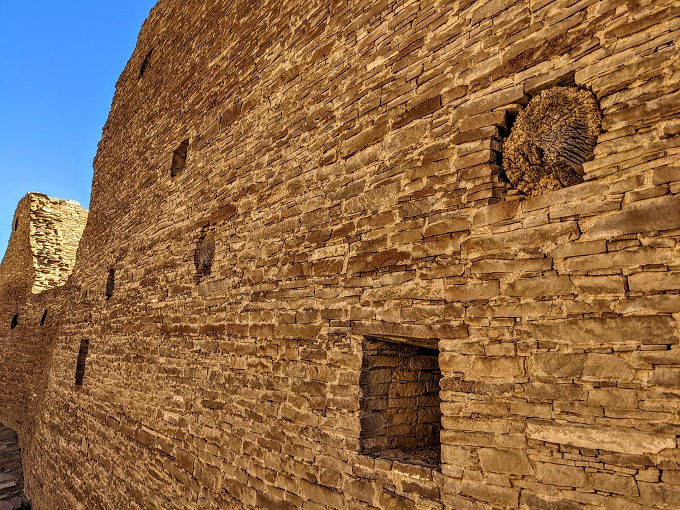
Chetro Ketl
After checking out Hungo Pavi, we drove another mile or two down the road to the next parking area. That parking lot serves two sites – Chetro Ketl and Pueblo Bonito. We headed off to the right to check out Chetro Ketl first.
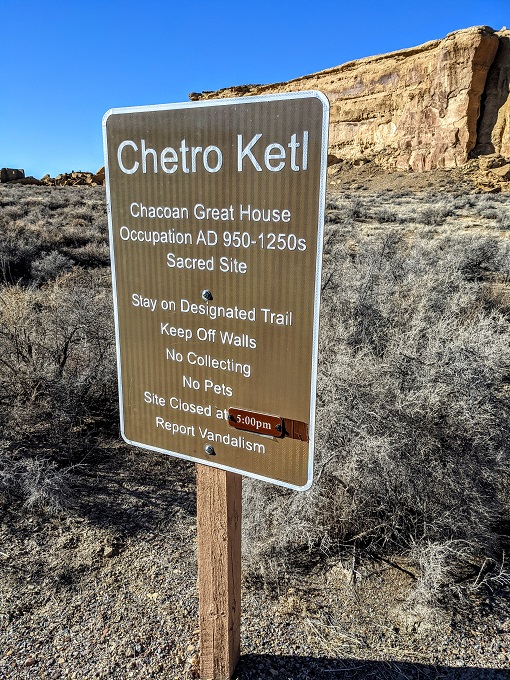
The route to Chetro Ketl is a loop trail; be sure to take the route alongside the rock face in at least one direction so that you see more petroglyphs along the way.
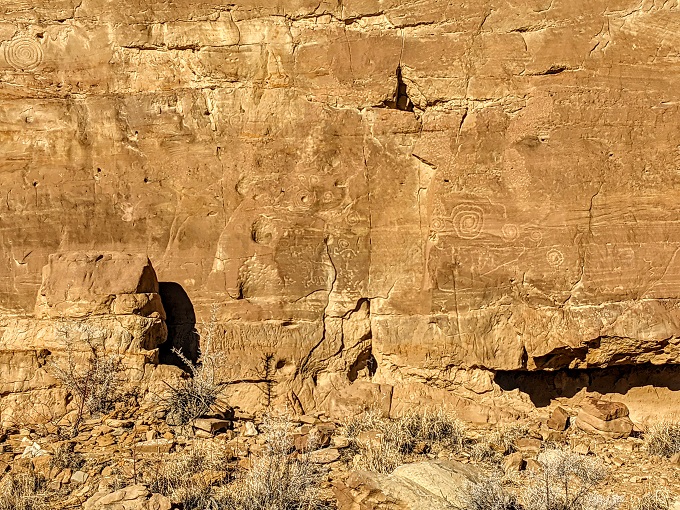
Chetro Ketl is the second largest great house in the park as the building was constructed over more than three acres.
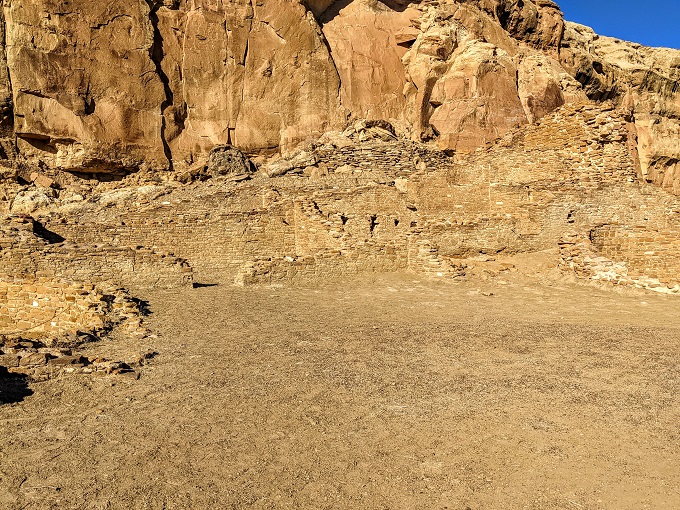
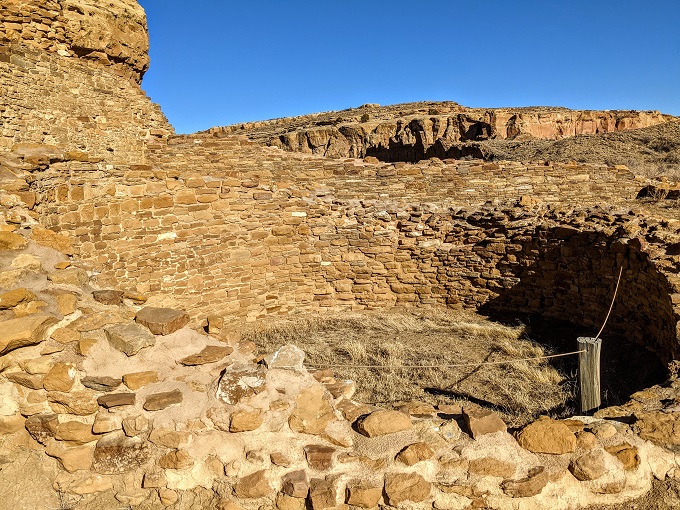
This great house was once three stories tall; its remains don’t give a true sense of how tall it once was, but some of the remains help give you an idea of how high it once rose above the canyon floor.
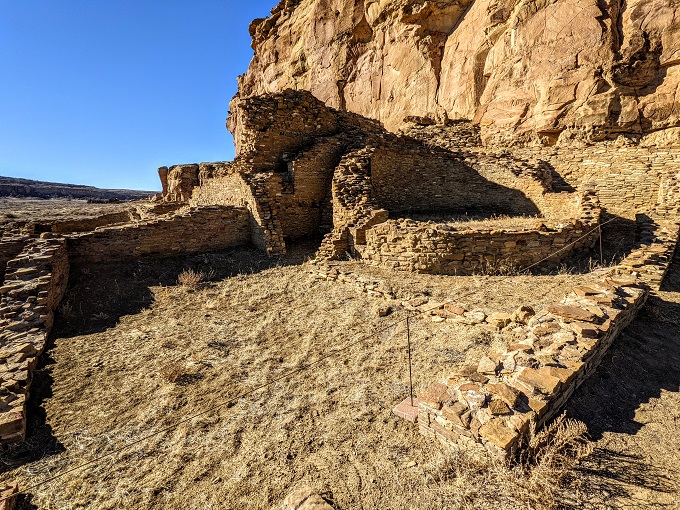
There’s a lot more to see of Chetro Ketl than the first two sites, so although you have to picture how tall the building once was, you don’t have to use as much imagination to picture its surface area.
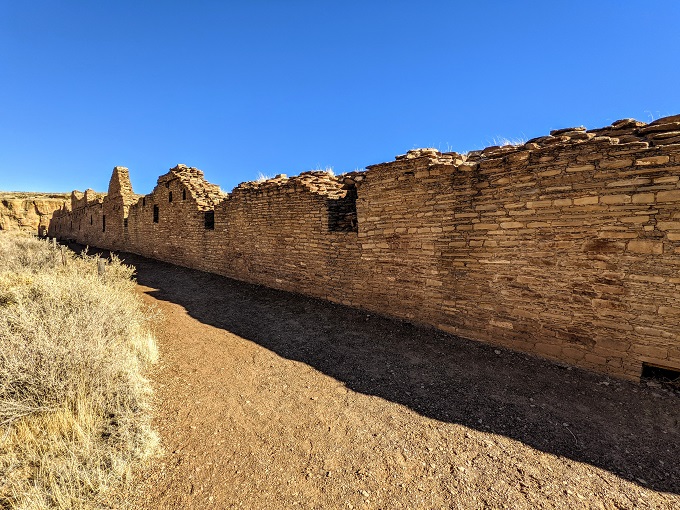
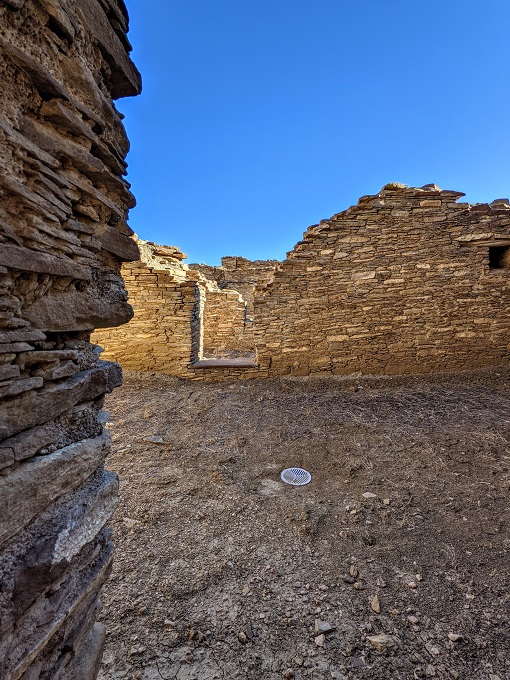
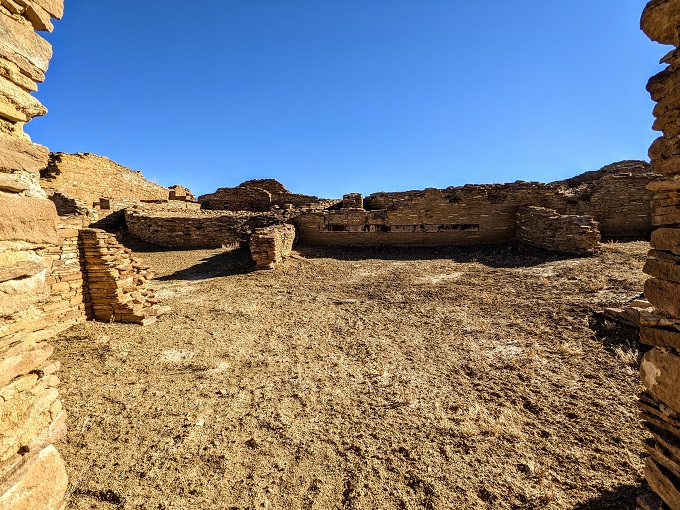
Once again, it’s worth paying attention to the masonry as you walk around to see the different construction methods used. The design of Chetro Ketl seemed a little more intricate; I can’t imagine how much effort went into its construction given how many smaller pieces of stone and rock were used.
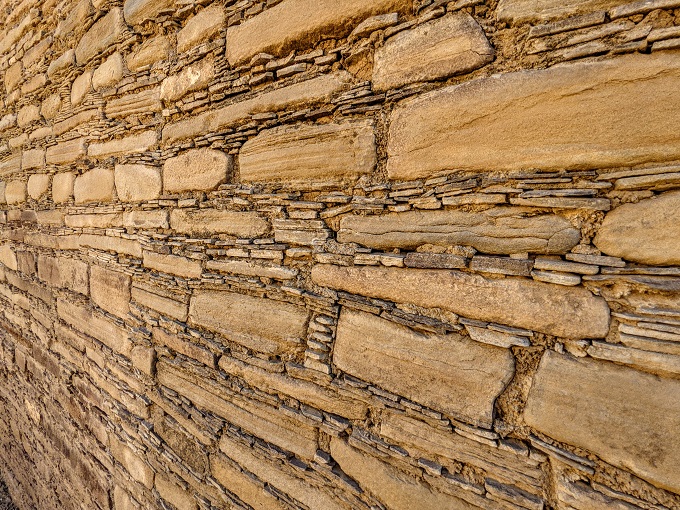
The trail loops around the building, so you can see the building from all sides. As we walked around, it became a little easier to imagine the great house’s height as two stories were more clearly visible.
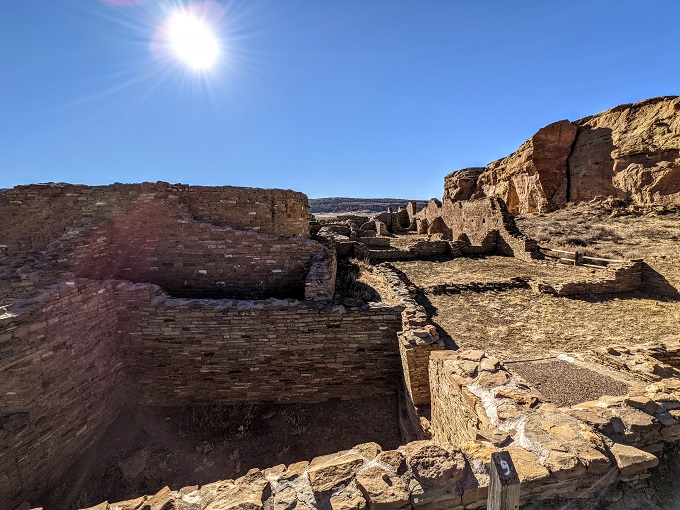
In case you’ve been wondering what a kiva is, here’s how the National Park Service describes it:
‘Kiva’ is a Hopi word used to refer to specialized round and rectangular rooms in modern Pueblos. Modern kivas are used by men’s ceremonial associations. Archeologists assume that ancient kivas served similar functions. Chacoan kivas are round, usually semi-subterranean, and built into great houses. Like modern kivas, they were entered by a ladder from the roof down to the center of the kiva floor. During ceremonies today, the ritual emergence of participants from the kiva into the plaza above represents the original emergence by Puebloan groups from the underworld into the current world. Late in the Chaco sequence two-to-three story tower kivas were also built.
As can be seen below, the Chetro Ketl great house contained a massive kiva.
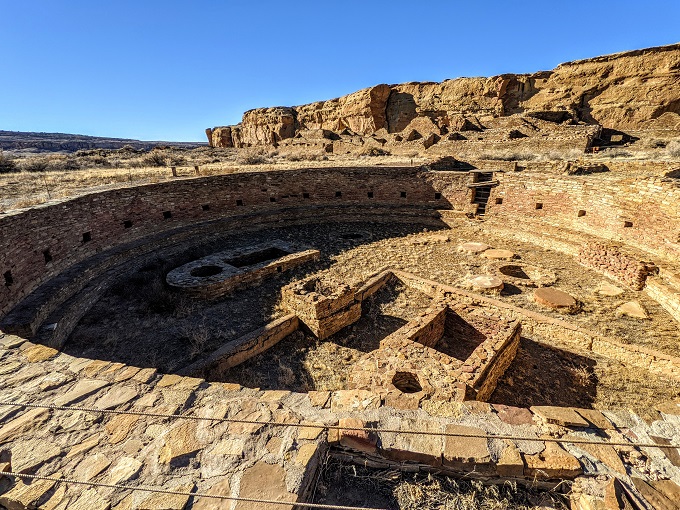
Pueblo Bonito
Once we’d taken a wander around Chetro Ketl, we headed over to Pueblo Bonito. Similar to Chetro Ketl, there’s a loop trail to the site and it’s worth taking the route along the rock face there and/or back as there are petroglyphs and interesting rock formations to see.
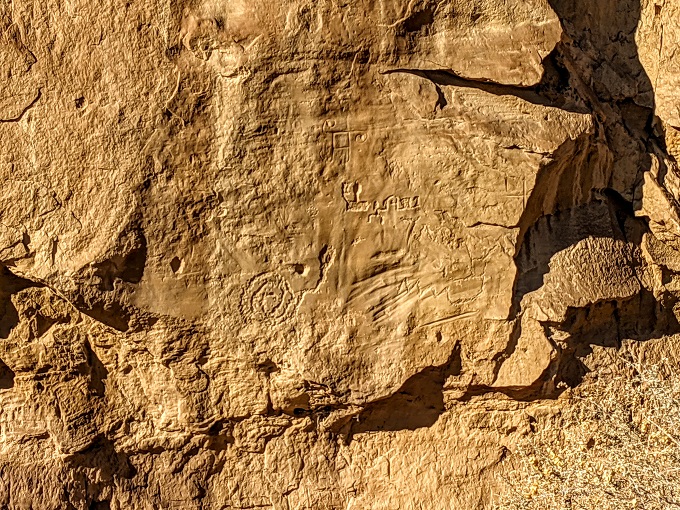
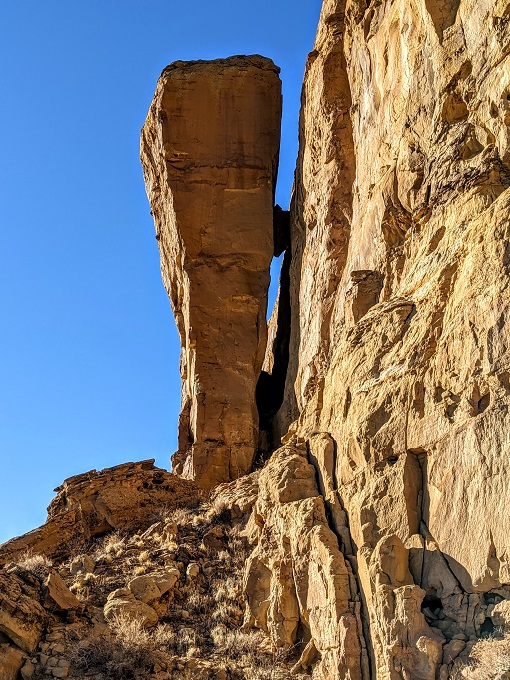
There were some strange markings on the rock face too, almost like Wolverine had visited the site. I’m guessing that this is where the Chacoan people sharpened tools and knives, but perhaps there’s another reason for the markings.
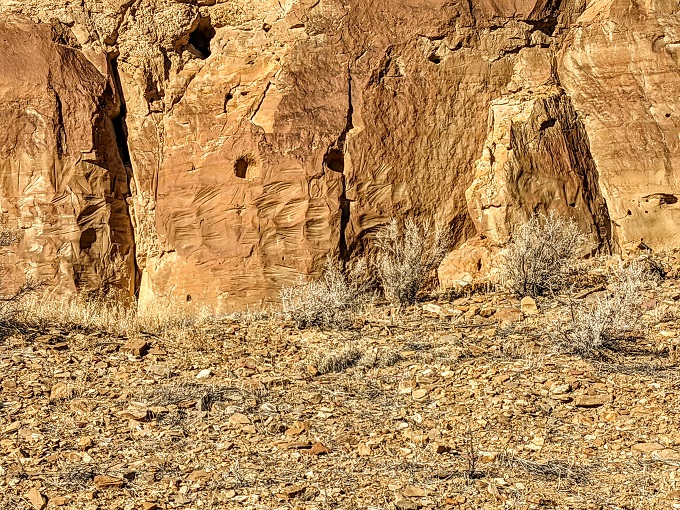
Pueblo Bonito is the largest great house in Chaco Culture National Historical Park and is the most important site there. As a result, if you’re pushed for time during your visit, this is the site you should prioritize seeing.
When taking the trail along the rock face, it leads to a platform that overlooks some of the site.
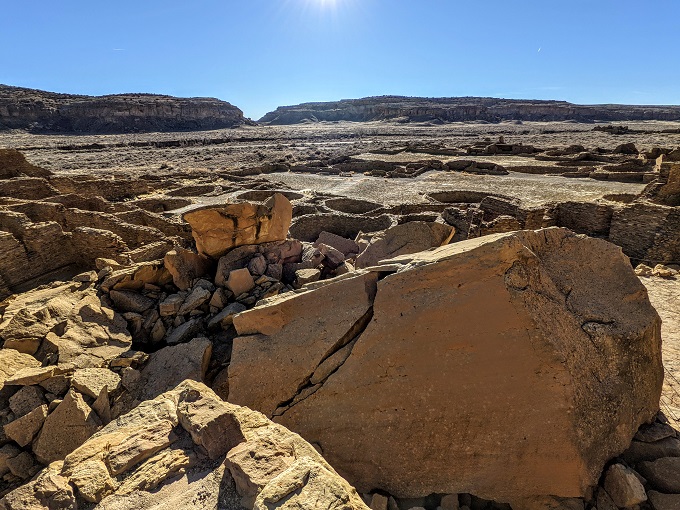
Although this gives a fairly good view from above, it looks like it’d be worth taking the trail to the Pueblo Bonito Overlook as that gives even more spectacular views from above based on this article.
Pueblo Bonito was enormous. It covered more than three acres, had more than 600 rooms and was built as high as five stories in some parts. Although you don’t get to see the great house in all its glory height-wise nowadays, you certainly get a sense of how spacious it was as you walk around.
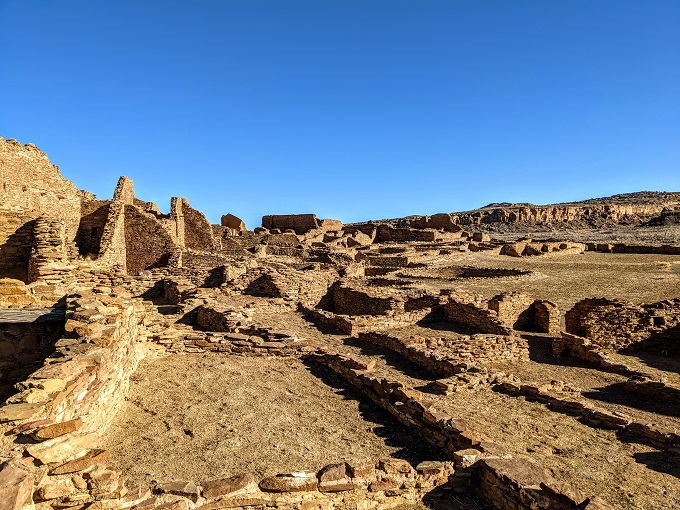
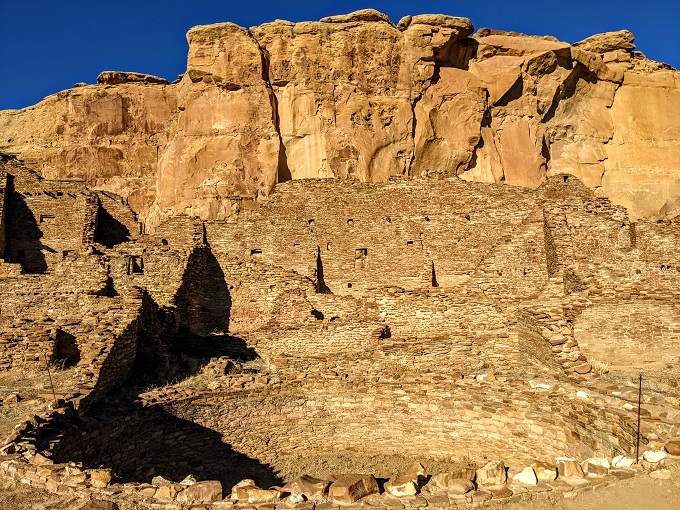
The trail runs around the site, but there are also some sections where you get to walk through the building and inside rooms.
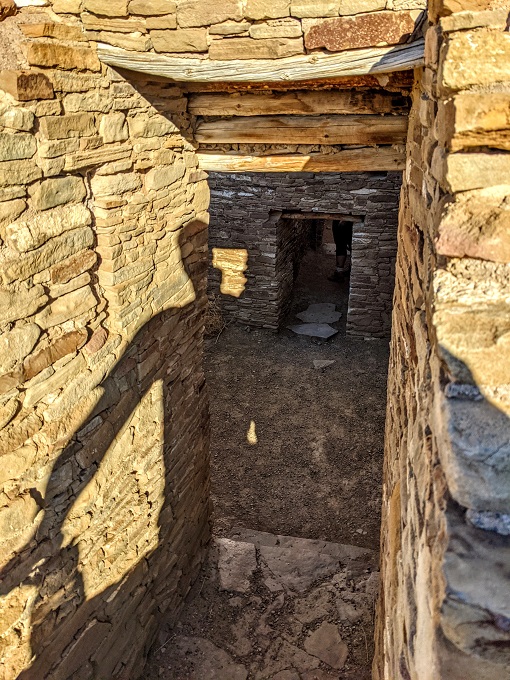
Be prepared to duck when walking through these well-maintained buildings as the doorways can’t be much more than 4 ft high – if that. I’m only 5′ 9″ and had to go through on my knees at times.
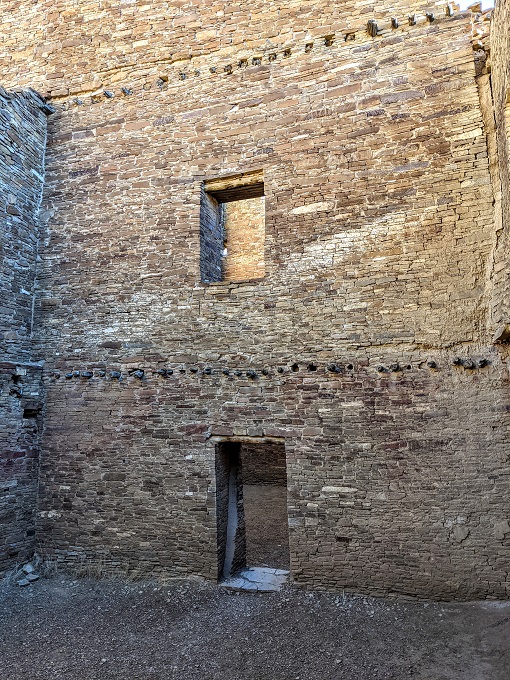
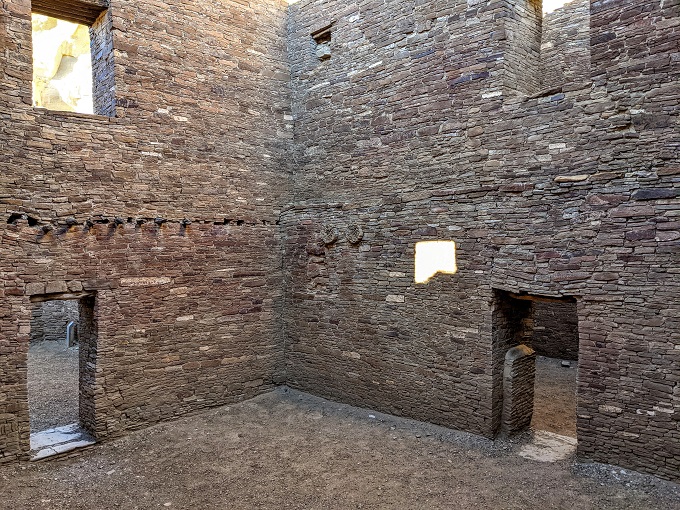
Construction on Pueblo Bonito began around 850 A.D. and continued expanding for approximately 300 years.
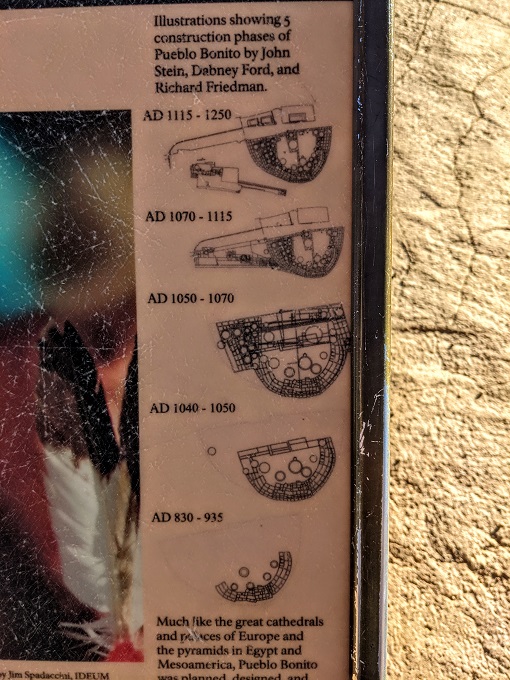
Between 1920 and 1927, there were seven expeditions by the National Geographic Society and Smithsonian Institution to unearth and preserve Pueblo Bonito. In total, they removed a hundred thousand tons of rubble and sand(!), while also reconstructing some sections of destroyed walls to match the original masonry.
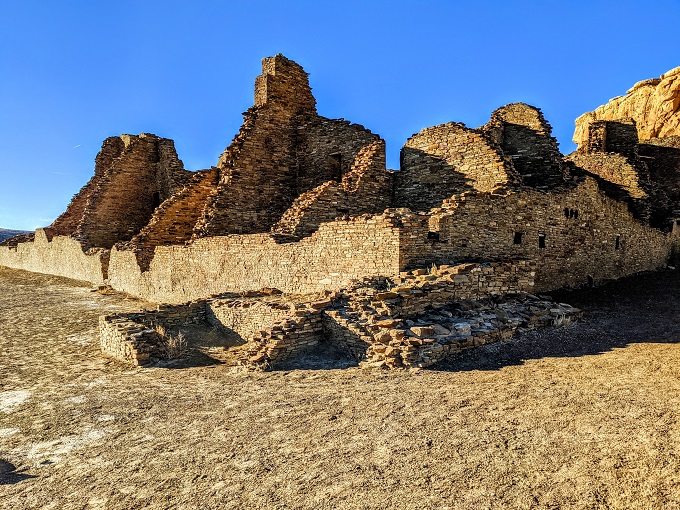
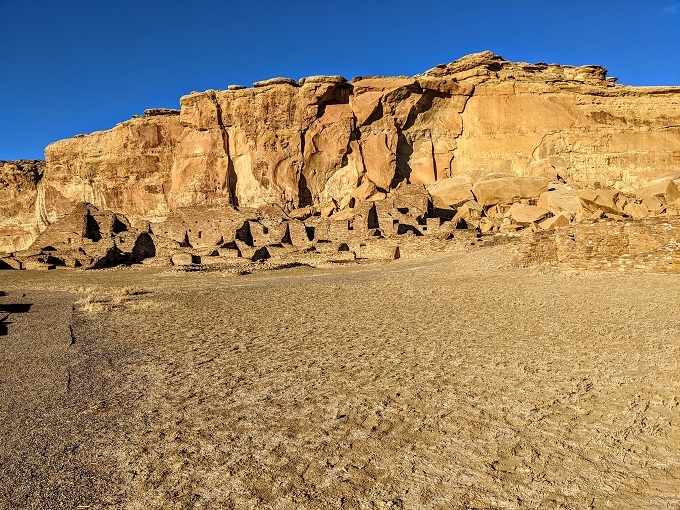
This great house had many kivas, but I think the one in the photo below was one of the largest.
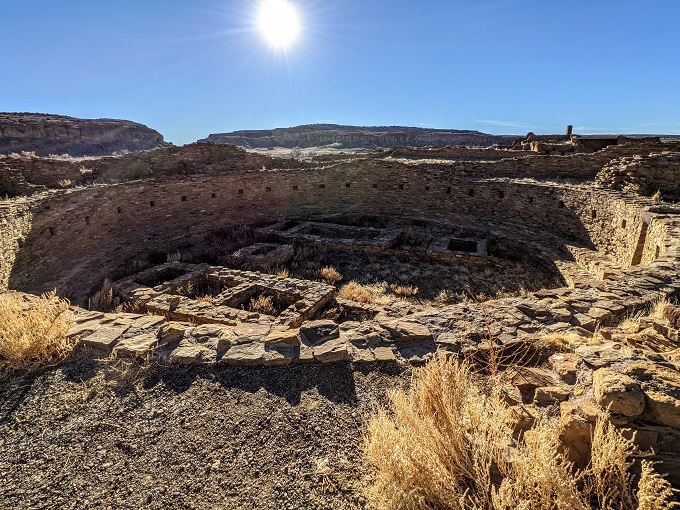
As we came to the end of the trail, there was a rendering of what Pueblo Bonito would’ve looked like in its heyday. All the circular constructions you can see are kivas; there would’ve been a ladder to enter down through the roof of each one.
I’m trying to imagine what it would’ve been like 1,000 years ago to be wandering through the wilderness of New Mexico and then suddenly come across this city.
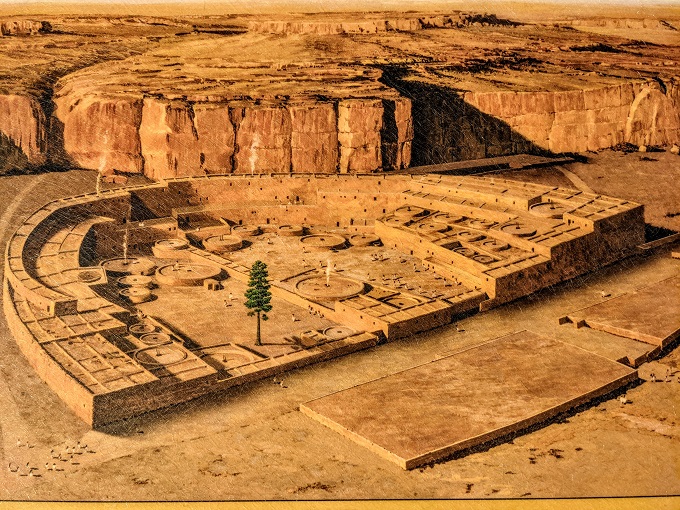
Wetherill Cemetery
Shae and I would’ve loved to have spent even more time exploring Pueblo Bonito, but it was almost 4:30pm at that point and the park closed at 5pm. We therefore hopped back in the car and drove the short distance to the fifth site – Pueblo del Arroyo.
The parking area for Pueblo del Arroyo is also right next to Wetherill Cemetery. There was a walking trail leading to Wetherill Cemetery back at Pueblo Bonito, but it’s worth just driving on as the trail to the cemetery from Pueblo del Arroyo’s parking lot is only 600 ft versus something like half a mile round trip (or more) from Pueblo Bonito.
As can be seen on the information board below, Richard Wetherill explored the area for much of his life, excavating sites and selling artifacts. I’m not sure how commendable he was though seeing as it was his activities which resulted in a law being created to protect antiquities.
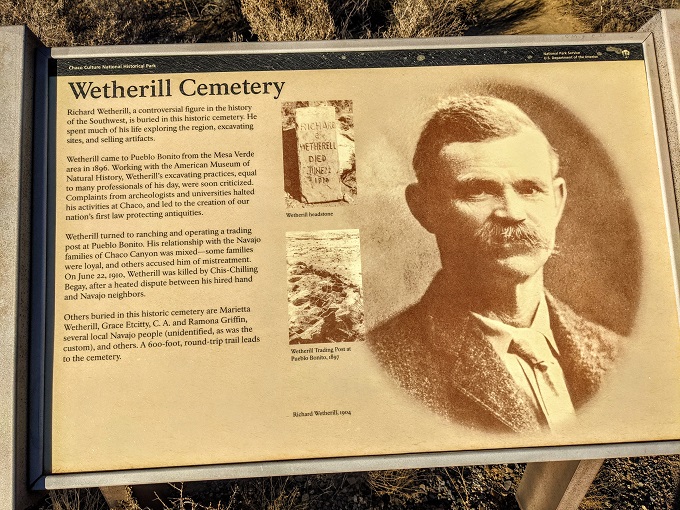
There wasn’t too much to the cemetery itself, so we only spent a moment there.
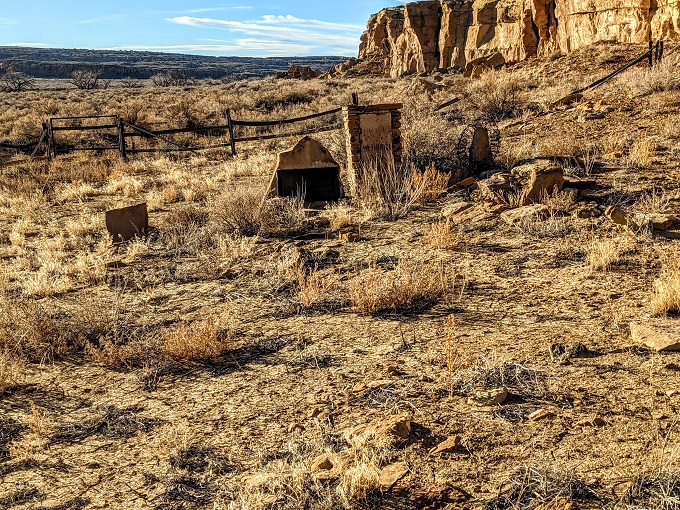
Pueblo del Arroyo
We then walked across the parking lot towards Pueblo del Arroyo. There was a one-way trail around this site; I’m not sure if they always have it set up that way or if it was put in place to help ensure physical distancing because of COVID.
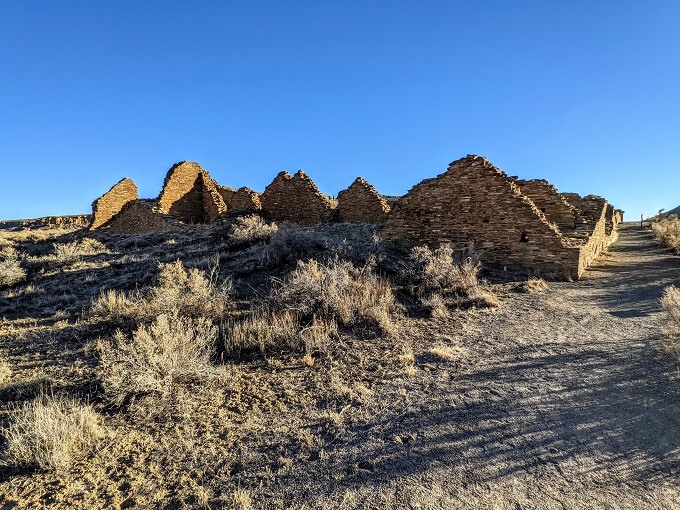
The trail is only about 0.25 miles round trip, so it didn’t take too long to explore which was good seeing as were pushed for time.
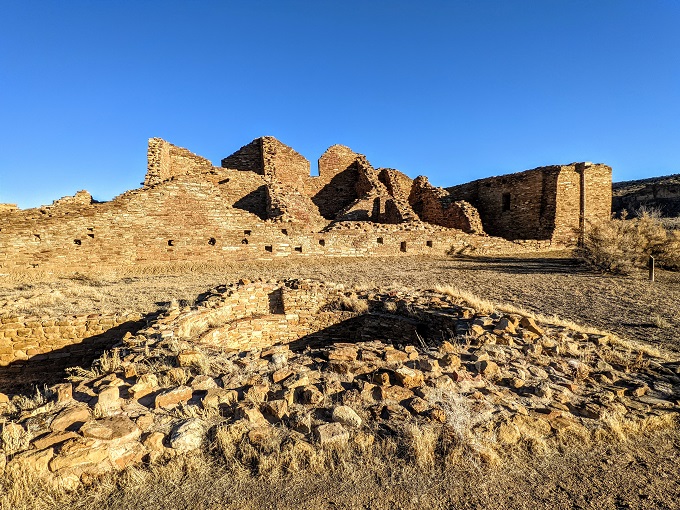
Pueblo del Arroyo is one of only a few Puebloan buildings which had a tri-walled kiva, but it’s not known if there was any significance to this kind of design.
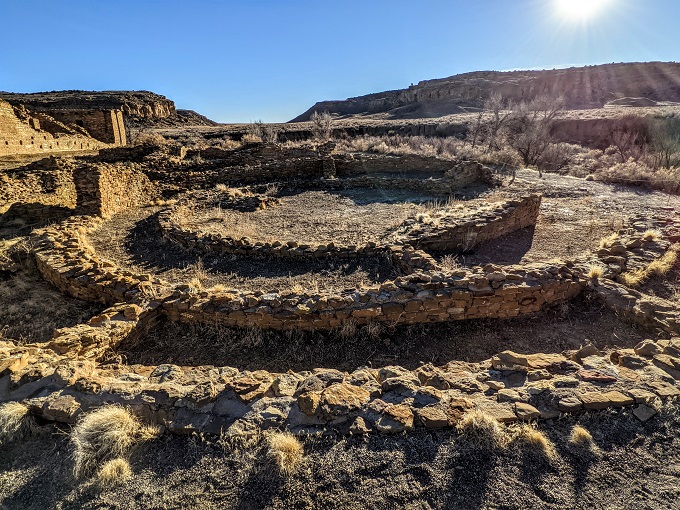
The trail loops around the remains of the great house and then back to the parking lot.

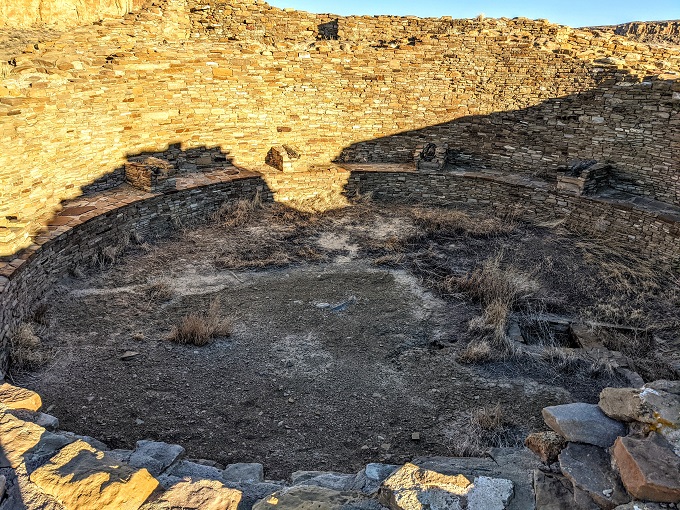
Hiking Trails
I mentioned earlier that there are several hiking trails you can take to some of the outlier sites. The trailheads for the Peñasco Blanco and Pueblo Alto trails can be found at the Pueblo del Arroyo parking lot.
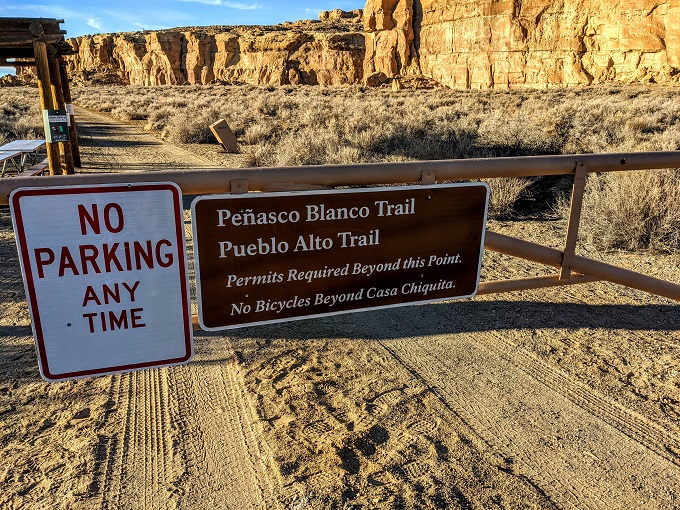
Pets aren’t allowed on the trails around the historic sites, but are allowed on these hiking trails.
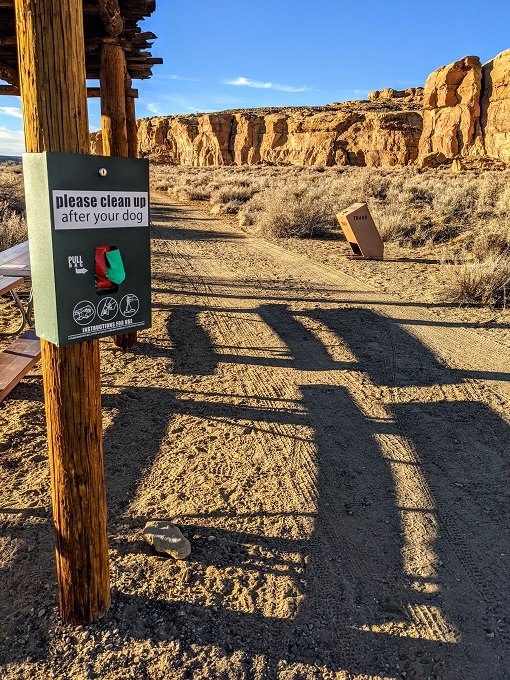
Be aware that Chaco Culture National Historical Park requires permits in order to hike on these longer trails; there’s a permit station at the trailhead. Note also that the trails close at 5pm; we saw a park ranger driving around the park promptly at 5pm and beeped when they reached this parking lot, presumably to alert nearby hikers who’d left their car in the parking lot that they needed to get a move on (we were finishing up at Casa Rinconada by that point).
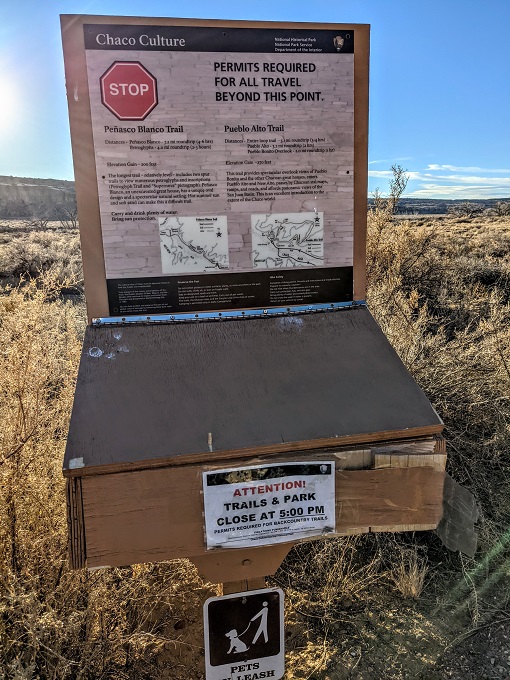
Casa Rinconada
The final main site in the park is Casa Rinconada. The first five sites are all on the northern side of Chaco Canyon, with only Casa Rinconada (and some outliers) on the southern side of the canyon. That means driving over a short bridge with Chaco Wash below.
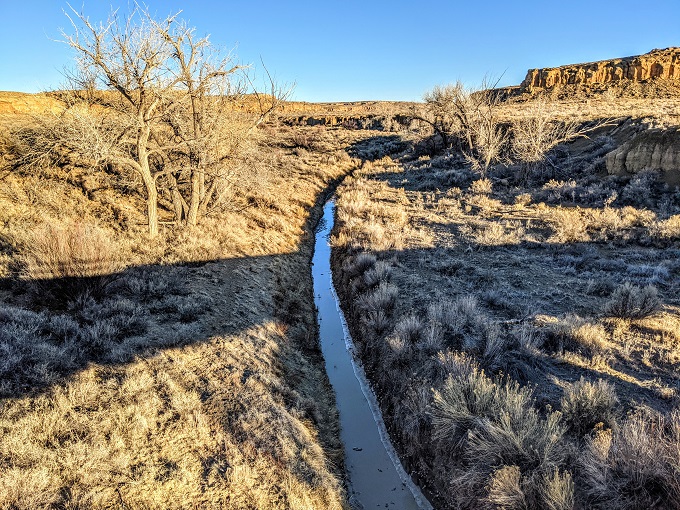
It was 4:55pm by the time we got to the parking area for Casa Rinconada, so we hustled up there as quickly as we could.
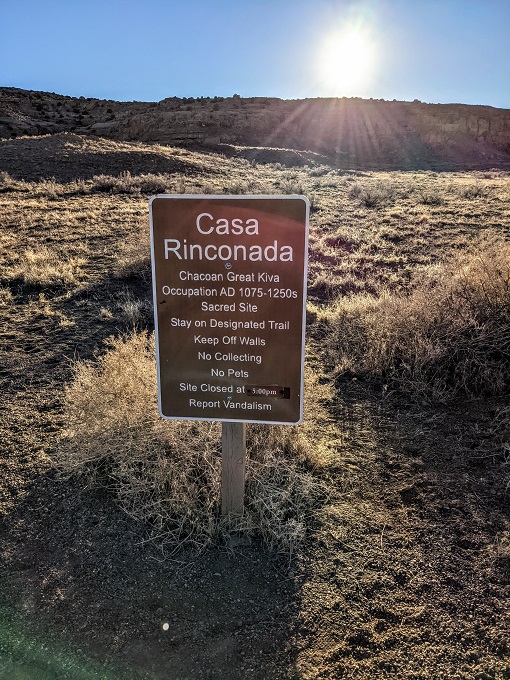
Unlike the previous five sites, Casa Rinconada wasn’t a great house. Instead, it was a great kiva. In fact, it’s the largest great kiva in all of Chaco Canyon – larger even than any found in Pueblo Bonito which was a much larger complex.
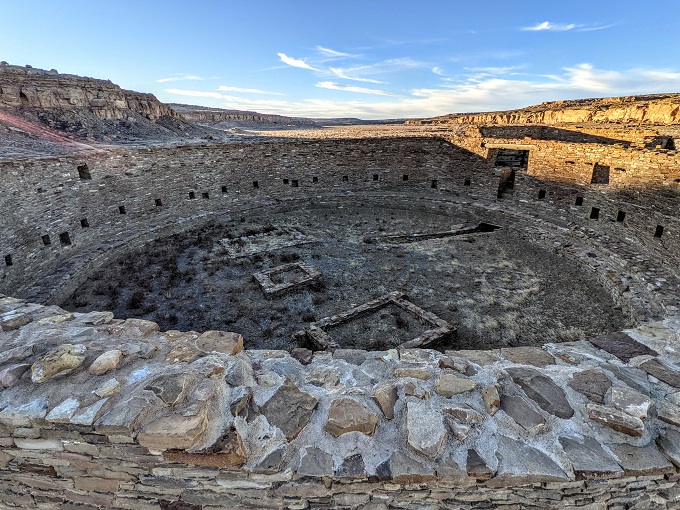
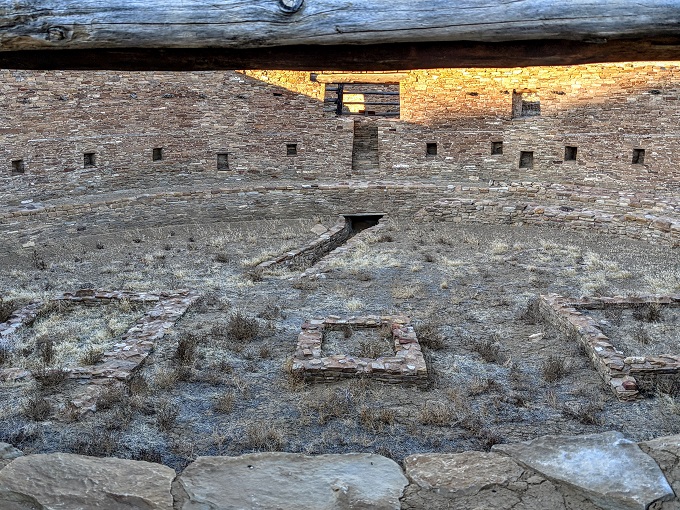
There was what seemed to be some kind of tunnel leading from one side of the kiva to its center. I’m not sure if that functioned as some kind of drainage system or if it was an entrance into the kiva.
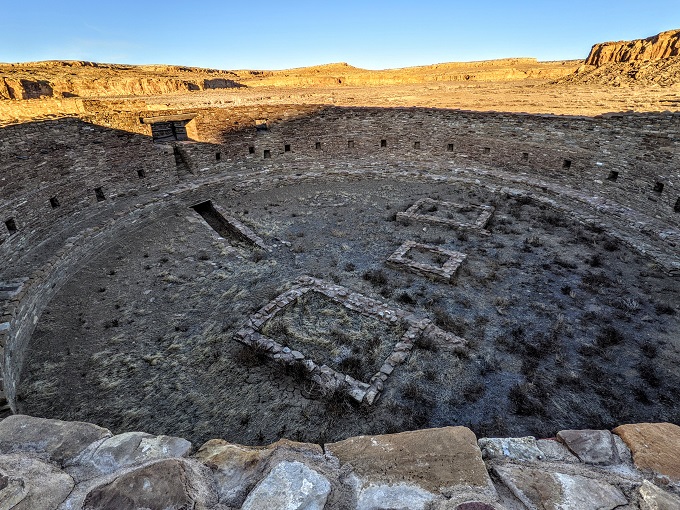
The Casa Rinconada trail is a half-mile loop trail which takes in the remains of nearby villages. Casa Rinconada is located on a bit of a hill, so we could see the park ranger driving through the park to ensure people were leaving at 5pm. We therefore only had time to check out the kiva (which is the main attraction of Casa Rinconada) and so only got to see the villages from a distance as we headed back down the short trail we’d originally come up.

Fajada Butte
As you enter and exit Chaco Culture National Historical Park, there’s a distinctive rock formation you can’t miss called Fajada Butte. On our way out of the park, there was a small parking area with a couple of picnic tables giving a great vantage point.
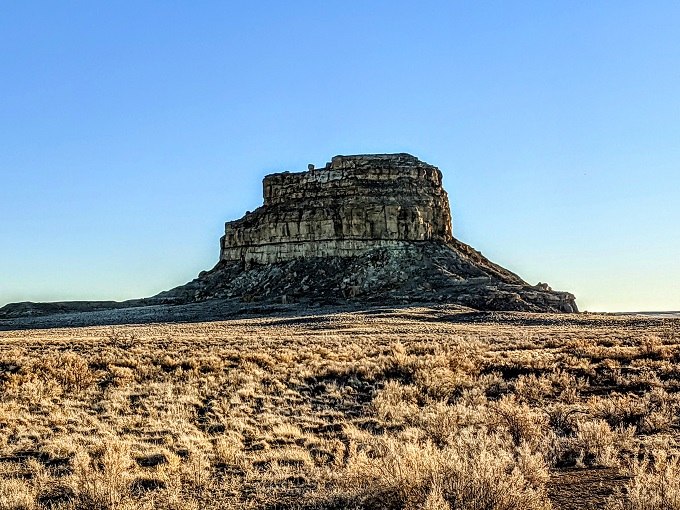
In addition to the picnic tables, there were a couple of information boards about Fajada Butte, including its importance to astronomers who lived 1,000 years ago.
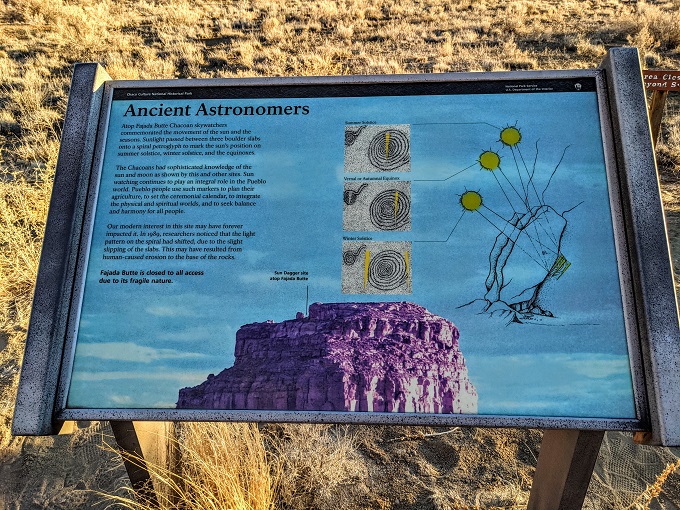
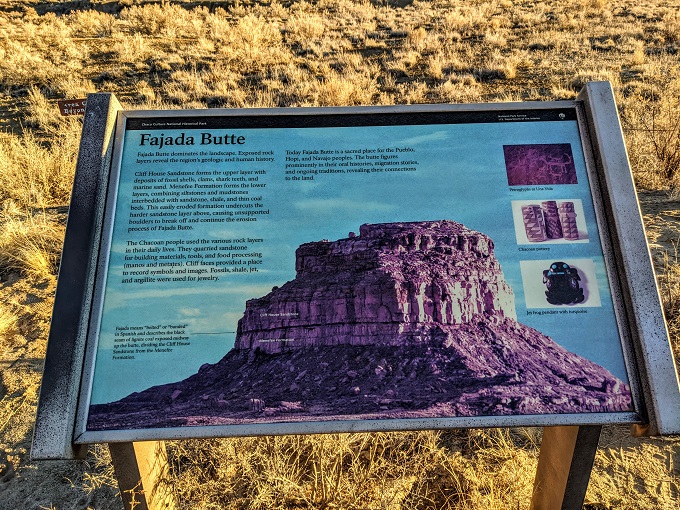
With the sun setting behind us, it was sadly time to take the long, bumpy road back towards our Airbnb in Bloomfield.
Final Thoughts
If you find yourself in New Mexico, I highly recommend taking the time to visit Chaco Culture National Historical Park. There’s so much fascinating history and architecture from 1,000 years ago, along with hiking trails with some beautiful scenery.
If you’re into camping, it’d certainly be worth spending a few days at the park. Not only so that you have more time to explore the area and hike the various trails to the outliers, but because the park is also an International Dark Sky Park which means you get much better views of the stars and Milky Way.
I love reading y’all’s travel summaries from different states! I’m a Kentuckian and I get a little rush knowing how much you all enjoyed the attractions here!
Thanks! I’m glad you’re enjoying following along 🙂
Love seeing these lesser known sites. Thanks!
I’m so glad I read about it on that other site as I’d not seen it mentioned elsewhere before.